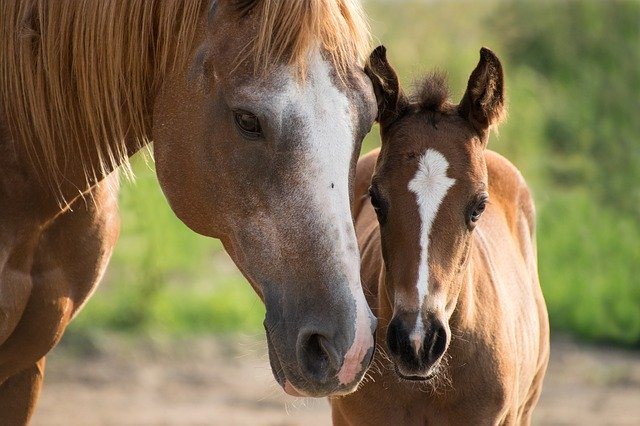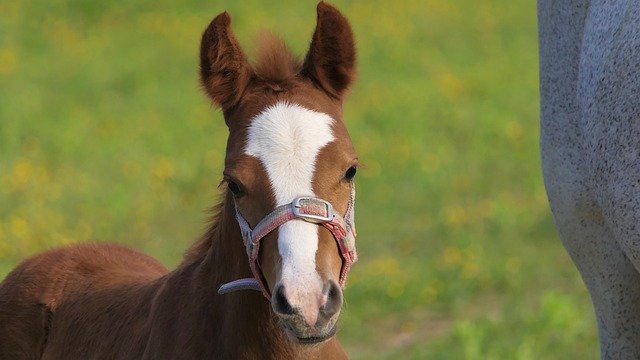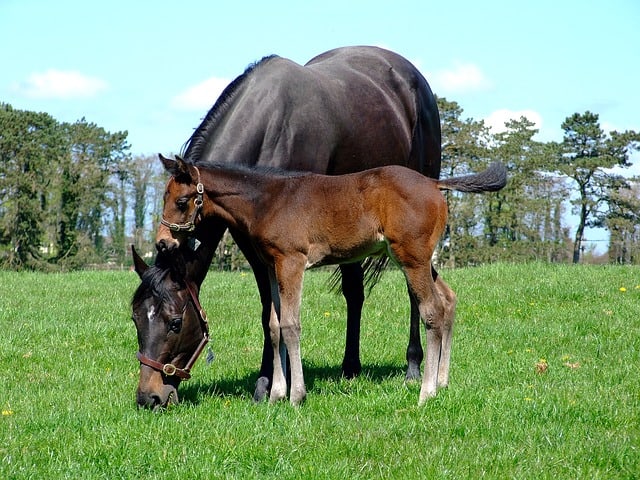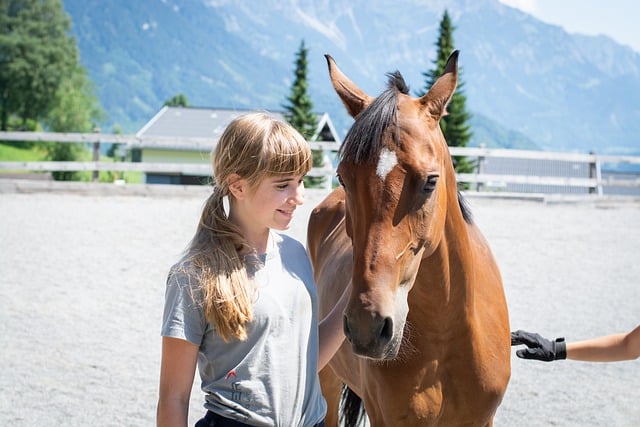Good Handling Starts On Day One!
I am a firm believer that correct early handling can put value on a young horse for the rest of its life. There is an old saying “He who teaches the young controls the future”. It is never more true than with young horses and begins with the foal. Lessons should start on day 1 with the foal being guided along beside the mare, a 2 person job. We can cash in on the fact that the young foal will usually want to follow the mare.

During the first 3 days the foal is learning to accept so many new things; it is easy for them to accept being touched and moved forward by a handler as they follow the mare. Much easier to do this now before they become more independent as they grow and get bigger and stronger.
Another task is to encourage the lifting of feet, it is not fair to expect your farrier to train your young horse and risk being kicked. I have heard farriers say that there are some yards they dread going to trim foals and youngsters; while in other yards they never mind going to do the job as all the young stock are so good, because they were used to having their feet picked out every day. This is a small step to having them rasped and very valuable if they should develop an abscess that needed treating. It is much easier to persuade a small foal to pick up a foot than a 6 month old weanling!
Good Handling Can Reduce the Stress of Weaning.
If acceptance of being touched and learning to lead are established while the foal is still on the mare, it will make the job of weaning much easier and less stressful for the weanling.

Stress is always a factor in weanlings, it contributes to them developing ulcers and “going backwards”. Separation stress at some level will always be present. However if we add to that stress by trying to start with unfamiliar situations and procedures, like leading for the first time and picking up feet or grooming then it is only adding to the stress levels and challenging the animal’s immune system more.
Stress has been proven to suppress the immune system that is why we should never wean if a foal is not 100% health wise. It therefore makes sense that we should try to keep stressful situations to a minimum if we want to keep our animals healthy. This is especially important if weanlings are going to sales or moving to a new yard where they may be in contact with new environmental challenges.

I am not a believer in over familiarization and playing with a foal, this can cause them to lack respect and over step boundaries when they are bigger, something that can be dangerous. However correct handling and training will establish the basics that can be built on in future training.
The Basic Important Lessons.
One of the most important things for me when working with young foals and horses is to teach them to move forward when being led and to move away from you when asked. This should be done in a positive fashion and not to cause fear of the handler but more respect. Remember they are prey animals and will resort to their natural instincts if frightened. If you ask then to do something then insist it is carried out even if it takes back up and a second person. Allowing the animal to get away with not responding in the desired fashion is basically teaching it that it’s O.K. to do what it is doing. Also remember to reward for good behaviour; use your voice or a scratch or a rub to praise.
A friend of mine who breeds thoroughbreds and sends them away to be prepped for yearling sales once said “I take the time to handle them daily when they come in to be fed. I groom them and pick up their feet before they are turned out again”. He believed that if the horse was easy to handle it would have more time spent on it than if it was unpleasant to deal with. He always had good results in the sale ring so I couldn’t argue with his philosophy.
So Why Are These Early Lessons Not Always Taught?
It’s about the economics of man hours. Initially you will need at least 2 people to lead out and teach the foal to lead, this could be for a few days or longer depending on the individual, the same for picking up feet and learning to be touched by a handler; these personnel need to be trained in how to do this correctly as bad handling at this stage is likely worse than no handling at all. Well trained staff are not only hard to find but have to be paid. Sometimes the short term goal is all that is factored in and the value of the initial training to the long term well being and value of the animal is overlooked due to the cost.
The Progression of Training.
As the horse matures and starts to be trained for having a rider on and accepting all the things that a ridden horse is expected to be good at, these early sessions that have been established will help with things like moving forward on the lunge, being groomed, having a rug on, accepting tack, boots, and even loading into a trailer or lorry.
Each new stage has to be introduced in a way the animal understands while being rewarded for the correct result. It seems to be a bit “old fashioned” to carry out a full groom after exercise and many horses are washed down and rugged up to dry. If they are not used to being touched all over then when it comes to clipping you cannot expect them to be accepting. Again this is an economic effect it takes trained staff and they have to be paid. If you start to add up the cost of production and include man hours it is quite staggering compared to the cost to the sale price and any profit is slim, if at all!

Not all horses are going to be world beaters, if a horse has the talent then a professional rider could overlook a bit of a quirk; they would have the resources and experience to cope with it. For example if it won’t stand to be mounted but jumps 1.40m then ok we can vault on. That’s no good for the less able horse that has only limited ability but would satisfy the leisure rider who wants to go for a nice hack and do some riding club activities.
Basic good manners need to be established from the start. How often do we hear “it must be good to box, shoe and clip”, the amateur rider and the leisure rider do not want to deal with difficult issues like this. These basics are hard to put in place later once the horse has been taught that it’s OK not to stand still or that an experience is unpleasant or uncomfortable. I have had some very sharp horses that were extremely sensitive that may not have been started quite slowly enough, you had to pay attention around them and be thinking ahead at all times. They would not be suitable for an inexperienced person or leisure rider, which is why they ended up with me; luckily they were quite talented, but were never sold on and were kept as schoolmasters.

In Conclusion
Training the horse is a progressive sequence of establishing understanding by repetition and acceptance without fear or hurry. Short cuts only lead to long term limitations. Each horse is slightly different, some more accepting, some brave, some sensitive, and each has their own speed of progress, some take more time for various different reasons. The greatest gift a trainer can give to a horse is patience and a good initial training. That way the horse will be much more likely to be treated kindly and valued. A horse that is limited in its ability can still have great value if it is easy to handle and had a good basic training. To be honest they are worth their weight in gold!
This Article by Jessica Soley BHSI was originally published in the July 2020 Issue of Irish Sport Horse Magazine. All Pictures are from Pixabay.
